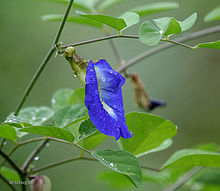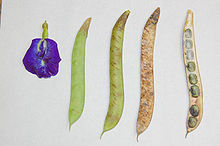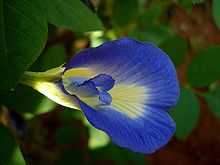- Clitoria ternatea
-
Clitoria ternatea 
Clitoria ternatea vine Scientific classification Kingdom: Plantae (unranked): Angiosperms (unranked): Eudicots (unranked): Rosids Order: Fabales Family: Fabaceae Genus: Clitoria Species: C. ternatea Binomial name Clitoria ternatea
L.Clitoria ternatea (sanskrit : ''श्वेतां, विष्णूक्रांता, )is a plant species belonging to the Fabaceae family.
Contents
Distribution
This plant is native to tropical equatorial Asia, but has been introduced to Africa, Australia and America.
Description
It is a perennial herbaceous plant. Its leaves are elliptic and obtuse. It grows as a vine or creeper, doing well in moist neutral soil. The most striking feature about this plant are its vivid deep blue flowers. They are solitary, with light yellow markings. They are about 4 cm long by 3 cm wide. There are some varieties that yield white flowers.
The fruits are 5 – 7 cm long, flat pods with 6 to 10 seeds in each pod. They are edible when tender.
It is grown as an ornamental plant and as a revegetation species (e.g., in coal mines in Australia), requiring little care when cultivated. Its roots fix nitrogen and therefore this plant is also used to improve soil quality.
Uses
In traditional Ayurvedic medicine, it has been used for centuries as a memory enhancer, nootropic, antistress, anxiolytic, antidepressant, anticonvulsant, tranquilizing and sedative agent.[1]
In Southeast Asia the flowers are used to colour food. In Malay cooking, an aqueous extract is used to colour glutinous rice for kuih ketan (also known as pulut tai tai in Peranakan/Nyonya cooking) and in nonya chang. In Thailand, a syrupy blue drink is made called nam dok anchan (น้ำดอกอัญชัน). In Burma the flowers are used as food, often they are dipped in batter and fried.
In animal tests the methanolic extract of Clitoria ternatea roots demonstrated nootropic, anxiolytic, antidepressant, anticonvulsant and antistress activity.[2] The active constituent(s) include Tannins, resins, Starch, Taraxerol & Taraxerone.
Clitoria ternatea root extracts are capable of curing whooping cough if taken orally[citation needed]. The extract from the white-flowered plant can cure goiter. The roots are used in ayurveda Indian medicine.[3]
Recently, several biologically active peptides called cliotides have been isolated from the heat-stable fraction of Clitoria ternatea extract. Cliotides belong to the cyclotides family[4] and acvities studies show that cliotides display potent antimicrobial activity against E. coli, K. pneumonia, P. aeruginosa and cytotoxicity against HeLa cells.[5] These peptides have potential to be lead compound for the development of novel antimicrobial and anti-cancer agents.
Names
The flowers of this vine have the shape of human female pudenda, hence the Latin name of the genus "Clitoria", from "clitoris". (Synonyms: Clitoris principissae.)[6] "Ternatea", the name of the species, comes from Ternate, a location in Indonesia.[citation needed] In some languages (Tamil, Malayalam) it is named after the seashell, which is a euphemism for a woman's external sexual organs.[citation needed]. The sinhala name seems to be free of such connotations.[7]
Owing to its similarity to a human body part, this plant has been ascribed properties affecting the same (a phenomenon also found in connection with the mandrake, among other plants). It was used traditionally to cure sexual ailments, like infertility and gonorrhea, to control menstrual discharge, and also as an aphrodisiac. This practice is rooted in an ancient belief recorded in the Doctrine of Signatures.[8]
Some common names are:
- Maldivian: Kulhadhilimaa, Nanreethimaa
- English: Butterfly pea, blue pea vine, mussel-shell climber, pigeon wings
- Hindi: Aparajita (अपराजिता)
- Bengali: Aparajita (অপরাজিতা)
- Kannada: Nagar hedi
- Malay: Bunga telang
- Malayalam: ശംഖുപുഷ്പം (Sankhupushpam)
- Marathi: गोकर्ण (Gokarna)
- Portuguese: Fula criqua
- Sanskrit: aparajita (अपराजिता), saukarnika , ardrakarni, girikarnika (गिरिकर्णिका), supuspi (सुपुष्पी), mohanasini (मोह्नाशिनी), vishadoshaghni (विषदोषघ्नी), shwetanama (श्वेतनामा)., Vishnukranta (विष्णुक्रांता), ashwakhura (अश्वखुरा)}
- Tamil: Sangu pu
- Thai: ดอกอัญชัน (dok anchan)
- Bahasa Indonesia: Bunga telang, bunga teleng, bunga biru
- Sinhala: (සිංහල)-Sri Lanka: "Katarodu" ("කටරොඩු") or "katarolu" or ("කටරොලු") (normally specify with colour "නිල් " ("Nil") for blue or purple and "සුදු" ("Sudu") for white)
- Khmer: ផ្កាជិវិតអមតៈ(phaka Amatak)
- Turkish: Mavi Kelebek Sarmaşığı
References
- ^ Mukherjee PK, Kumar V, Kumar NS, Heinrich M"The Ayurvedic medicine Clitoria ternatea-From traditional use to scientific assessment." J Ethnopharmacol. 2008 Sep 20;
- ^ Jain, N (2003). "Clitoria ternatea and the CNS". Pharmacology Biochemistry and Behavior 75: 529. doi:10.1016/S0091-3057(03)00130-8.
- ^ "APARËJITË (Root)". The Ayurvedic Pharmacopoeia of India (Part I Volume II). Ministry of Health and Family Welfare. pp. 10–11. http://www.ayurveda.hu/api/API-Vol-2.pdf.
- ^ Nguyen GK, Zhang S, Nguyen NT, Nguyen PQ, Chiu MS, Hardjojo A, Tam JP.,"Discovery and characterization of novel cyclotides originated from chimeric precursors consisting of albumin-1 chain a and cyclotide domains in the Fabaceae family. J Biol Chem. 2011 Jul 8;286(27):24275-87
- ^ Nguyen, Kien Truc Giang; Zhang, S; Nguyen, N. T.; Nguyen, P. Q.; Chiu, M. S.; Hardjojo, A.; Tam, J. P. (8). "Discovery and Characterization of Novel Cyclotides Originated from Chimeric Precursors Consisting of Albumin-1 Chain a and Cyclotide Domains in the Fabaceae Family". Journal of Biological Chemistry 286 (27): 24275–24287. doi:10.1074/jbc.M111.229922. http://www.jbc.org/content/286/27/24275.abstract. Retrieved July 8, 2011.
- ^ Pharmacopia Indica Awl
- ^ Sinhala botany website
- ^ Fantz, Paul R. (1991). "Ethnobotany of Clitoria (Leguminosae)". Economic Botany (New York Botanical Garden Press) 45 (4): 511–20. doi:10.1007/BF02930715 (inactive 2010-04-21). JSTOR 4255394.
External links
- "Plant of the Week—Clitoria ternatea". http://www.plantoftheweek.org/week043.shtml. Retrieved 2007-07-31.
- "Clitoria ternatea". Tropical Forages. http://www.tropicalforages.info/key/Forages/Media/Html/Clitoria_ternatea.htm. Retrieved 2007-07-31.
- Caldecott, Todd (2006). Ayurveda: The Divine Science of Life. Elsevier/Mosby. ISBN 0723434107. Contains a detailed monograph on Clitoria ternatea (Shankhapushpi) as well as a discussion of health benefits and usage in clinical practice. Available online at http://www.toddcaldecott.com/index.php/herbs/learning-herbs/330-shankapushpi
- Clitoria Ternatea Picture and Video
Categories:- Clitoria
- Flora of Indonesia
- Flora of Thailand
- Flora of Malaysia
- Flora of Singapore
- Flora naturalised in Australia
- Forages
Wikimedia Foundation. 2010.




